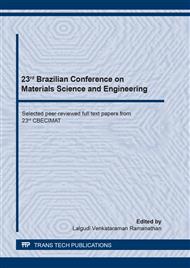[1]
W.D. Callister Jr, D.G. Rethwisch: Ciência e Engenharia de Materiais: Uma Introdução. (LTC, Nenith ed. Rio de Janeiro, 2016).
Google Scholar
[2]
L. Ceschini, E. Lanzoni, C. Martini, D. Prandstraller, G. Sambogna: Wear Vol. 264 (1-2) (2008), p.86.
DOI: 10.1016/j.wear.2007.01.045
Google Scholar
[3]
M.J. Donachie: Titanium: a Technical Guide. 9Materials Park, Second ed. Ohio, 2000).
Google Scholar
[4]
C. Leyens, M. Peters: Titanium and Titanium Alloys: Fundamentals and Applications.: (Wiley – VCH Verlag GmbH & CO Weinheim, 2003).
Google Scholar
[5]
C.H.S. Pereira: Um estudo sobre a dureza e os mecanismos de desgaste de materiais metálicos em altas temperaturas. Trabalho de Conclusão de Curso (Graduação em Engenharia de Materiais), UFSC, Florianópolis, (2010).
DOI: 10.11606/t.3.2007.tde-08052007-165239
Google Scholar
[6]
G. Gautam: Thermal oxidation of Ti6Al4V for bio-implementation. Master (Dissertation). Odisha, 2011. National Institute of Technology Rourkela (NITR). (IN).
Google Scholar
[7]
S.E. Espindola: Influência da oxidação térmica sobre as propriedades da liga Ti6Al4V para aplicações em próteses – tratamento térmico de 5 horas em ar ambiente. Tecnologias para competitividade industrial, Florianópolis, n. esp. (2012) 92-104.
DOI: 10.18624/e-tech.v0i0.225
Google Scholar
[8]
J. Lucchiari, N. Bergamaschi. Investigação eletroquímica da superfície de titânio tratada por oxidação térmica. Doutorado (Tese). Florianópolis, 2014. Universidade Federal de Santa Catarina (UFSC). (SC).
DOI: 10.5196/physicae.v11i11.311
Google Scholar
[9]
D.A.H. Hanaor, C.C. Sorrell: Journal of Materials Science Vol. 46 (4) (2011), p.855.
Google Scholar
[10]
A. Biswas, J.D. Majumdar: Materials Characterization Vol. 60 (6) (2009), p.513.
Google Scholar
[11]
F. Borgioli, E. Galvanetto, F. Iozzelli, G. Pradelli: Materials Letters Vol. 59 (17) (2005), p.2159.
DOI: 10.1016/j.matlet.2005.02.054
Google Scholar
[12]
Y. Luo, W. Chen, M. Tian, S. Teng: Tribology International Vol. 89 (2015), p.67.
Google Scholar
[13]
H. Güleryüz, H. Çimenoğlu: Biomaterials Vol. 25 (2004), p.3325.
Google Scholar
[14]
I. Hacisalioglu, F. Yildiz, A. Alsaran, G. Purcek: Materials Science and Engineering Vol. 174 (1) (2017), p.012055.
Google Scholar
[15]
M.A.M. Silva, P.V.A. Guerra, R.A.M. Valentim, H.R. Hékis, K.D. Coutinho, N.C.L.B. Guerra: Revista Brasileira de Inovação Tecnológica em Saúde ISSN, 2 (2015), p.59.
DOI: 10.18816/r-bits.v5i2.7249
Google Scholar
[16]
K.L. Rutherford, I.M. Hutchings: Surface and Coatings Technology Vol. 79 (1996), p.231.
Google Scholar
[17]
H.L. Du, P.K. Datta, D.B. Lewis, J.S. Burnell-Gray: Corrosion Science Vol. 36 (4) (1994), p.631.
Google Scholar
[18]
E. Gemelli, N.H.A. Camargo. Oxidation kinetics of commercially pure titanium. Revista Matéria Vol. 12 (3) (2007), p.525.
DOI: 10.1590/s1517-70762007000300014
Google Scholar
[19]
J.O. Pereira Neto, R.O.D. Silva, E.H.D. Silva, J.A. Moreto, R.M. Bandeira, M.D. Manfrinato, L.S. Rossino: Materials Research Vol. 19 (6) (2016), p.1241.
DOI: 10.1590/1980-5373-mr-2015-0656
Google Scholar


